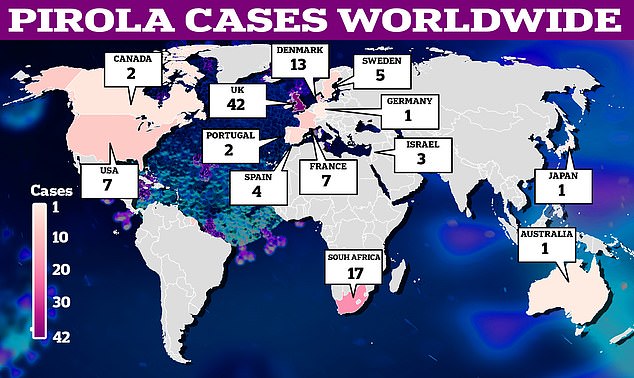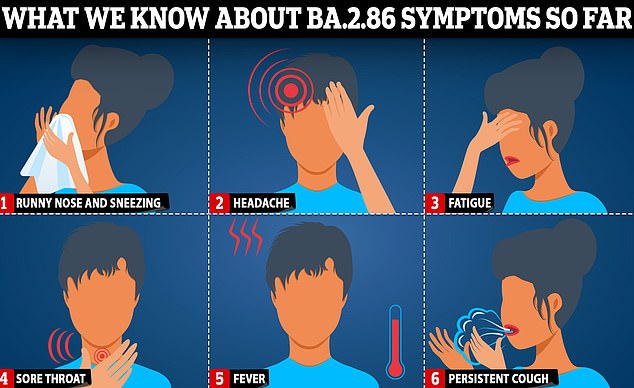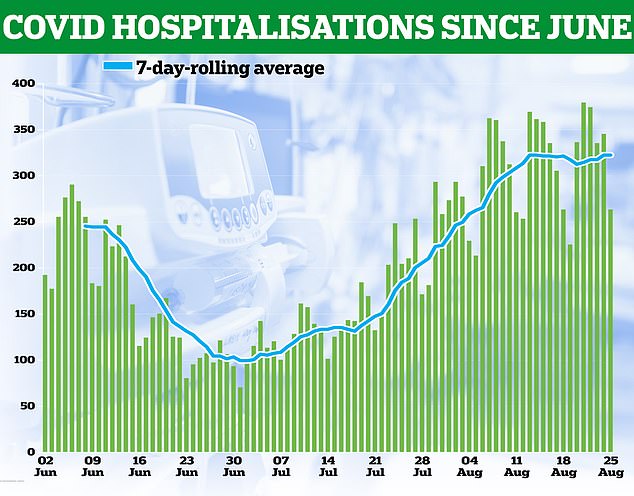How big is the Pirola outbreak in YOUR region? As the number of mutant strain cases rises to 42, the map reveals UK hotspots
A total of 42 cases of the super-mutated Pirola Covid variant have now been seen in Britain, up from 36 last week.
The UK Health Security Agency (UKHSA) has revealed where in Britain the new Covid variant, scientifically called BA.2.86, has been found.
The east of England had the highest number of cases thanks to the massive outbreak of 28 cases in Norfolk nursing homes at the end of August.
Excluding this particular event, London was the UK’s Pirola hotspot, recording six cases, followed by Scotland, which has reported five.
Of the 37 cases in England detected on September 11, seven were hospitalized, while two were detected among A&E patients.
No deaths have been recorded among those infected.
The UK Health Security Agency (UKHSA) has revealed where in Britain the new Covid variant, scientifically called BA.2.86, has been found. The east of England had the highest number of cases thanks to the massive outbreak of 28 cases in Norfolk nursing homes at the end of August

More than 100 cases of Pirola have been detected worldwide, including in Australia, Canada, Denmark, France, Germany, Israel, Japan, Portugal, South Africa, South Korea, Spain, Sweden and the US.

Although virologists have cautioned that it is too early to reliably pinpoint the specific symptoms of BA.2.86, its precursor BA.2 showed some telltale signs. Experts aren’t sure yet, but if it behaves like similar Omicron subvariants, signs to look out for include a runny nose, sore throat and fatigue.
The UKHSA said only two cases found in the community are believed to be linked, suggesting the virus is spreading among the public.
Pirola, scientifically called BA.2.86, now accounts for 2.6 per cent of all genetically analyzed Covid cases in England.
However, UKHSA analysts said there was still insufficient data to estimate the variant’s growth rate.
Although Britain’s official Pirola count is 42, the real total will be much higher as it spreads undetected in the community, experts say.
Britons are no longer testing en masse as they did earlier in the pandemic – with community testing ending in May 2022.
Therefore, the confirmed cases are an underestimate of how many Britons are infected with Covid and how many of those have Pirola.
Concerns about Pirola and a possible rise in cases prompted ministers to bring forward the start date for the rollout of Covid-19 and flu shots in the autumn by a whole month.
Pirola, like other recently emerged Covid variants, is a spin-off of the Omicron strain.
However, the large number of mutations, 35 in total, raised alarm, with some experts fearing it would be different enough to effectively evade the protection provided by Covid vaccines and infections from previous waves.
The UKHSA said it is currently analyzing blood samples from NHS workers to test how effective the immune response generated by Covid jabs is against Pirola.
Experiments to determine how effective lateral flow tests are in detecting Pirola are also ongoing.
The UKHSA also confirmed last month that Covid testing and community surveillance would be ramped up again before winter.

The number of hospital admissions and the number of beds occupied by Covid patients had also increased. Latest NHS data shows daily Covid hospital admissions have risen by almost 30 per cent since June, with a seven-day rolling average of 322 on August 25, up from 251 on June 7
Experts have told MailOnline that current data suggests that while Pirola is more transmissible than its predecessors, it does not appear to be more serious.
While the true prevalence of the virus is unclear, data from the ZOE Covid study, which tracks self-reported infections, suggests there were 100,516 new cases of symptomatic infection on September 12 – double the 50,000 reported in early August.
The research, which is based on data from millions of ZOE app users, estimates that around 1.2 million people in Britain are currently infected, around one in 57 people.
The figure is the highest in five months, but that’s about it still much lower than the estimated toll during previous peaks, which reported 3.8 million people infected by April 2022.
Experts predict that Covid cases will continue to rise as Britain moves into autumn and people socialize more indoors.
No Pirola cases have been detected in Wales and Northern Ireland.
More than 100 cases of Pirola have been detected worldwide, including in Australia, Canada, Denmark, France, Germany, Israel, Japan, Portugal, South Africa, South Korea, Spain, Sweden and the US.
